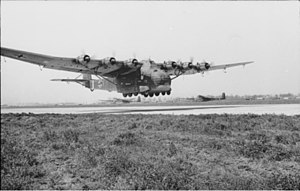Messerschmitt Me 323
| Me 323 Gigant | |
|---|---|
 |
|
| Role | Heavy transport |
| Manufacturer | Messerschmitt A.G. |
| First flight | April 1942 |
| Introduction | 1943 |
| Retired | 1944 |
| Primary user | Luftwaffe |
| Produced | 1942–1944 |
| Number built | 198 |
| Developed from | Messerschmitt Me 321 |
The Messerschmitt Me 323 Gigant ("Giant") was a German military transport aircraft of World War II. It was a powered variant of the Me 321 military glider and was the largest land-based transport aircraft of the war. A total of 213 are recorded as having been made, a few being converted from the Me 321.
The Me 323 was the result of a 1940 German requirement for a large assault glider in preparation for Operation Sea Lion, the projected invasion of Great Britain. The DFS 230 light glider had already proven its worth in the Battle of Fort Eben-Emael in Belgium (the first ever assault by gliderborne troops), and would later be used successfully in the invasion of Crete in 1941.
However, in order to mount an invasion across the English Channel, the Germans would need to be able to airlift vehicles and other heavy equipment as part of an initial assault wave. Although Operation Sea Lion was cancelled, the requirement for a heavy air transport capability still existed, with the focus now on the forthcoming Operation Barbarossa, the invasion of the Soviet Union.
On 18 October 1940, Junkers and Messerschmitt were given just 14 days to submit a proposal for a large transport glider. The emphasis was still very much on the assault role: the ambitious requirement was to be able to carry either an 88 mm gun and its half-track tractor, or a Panzer IV medium tank. The Junkers Ju 322 Mammut reached prototype form but was eventually scrapped due to difficulties in procuring the necessary high-grade timber for its all-wood construction and, as was discovered during the Mammut's only test flight, an unacceptably high degree of instability inherent in the design. The proposed Messerschmitt aircraft was originally designated Me 261w — partly borrowing the designation of the long-range Messerschmitt Me 261 long-range aircraft, then changed to Me 263 (later re-used for Messerschmitt's improved rocket fighter design) and eventually became the Me 321. Although the Me 321 saw considerable service in Russia as a transport, it was never used for its intended role as an assault glider.
...
Wikipedia
